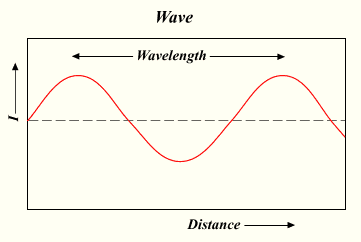Wavelength
|
|
The wavelength is the distance between repeating units of a wave pattern. It is commonly designated by the Greek letter lambda (λ).
In a sine wave, the wavelength is the distance between peaks:
The x axis represents distance, and I would be some varying quantity (for instance air pressure for a sound wave or strength of the electric or magnetic field for light), at a given point in time as a function of x.
Wavelength λ has an inverse relationship to frequency f, the number of peaks to pass a point in a given time. The wavelength is equal to the speed of the wave type divided by the frequency of the wave. When dealing with electromagnetic radiation in a vacuum, this speed is the speed of light c, for signals (waves) in air, this is the speed of sound in air. The relationship is given by:
- <math>
\lambda = \frac{c}{f} <math> where:
- λ = wavelength of a sound wave or electromagnetic wave
- c = speed of sound in air = 343 m/s at 20 �C (68 �F)
- f = frequency of the wave
For radio waves this relationship is approximated with the formula: wavelength (in metres) = 300 / frequency (in megahertz).
When light waves (and other electromagnetic waves) enter a medium, their wavelength is reduced by a factor equal to the refractive index n of the medium but the frequency of the wave is unchanged. The wavelength of the wave in the medium, λ' is given by:
- <math>
\lambda^\prime = \frac{\lambda_0}{n} <math> where:
- λ0 is the vacuum wavelength of the wave
Wavelengths of electromagnetic radiation, no matter what medium they are travelling through, are usually quoted in terms of the vacuum wavelength, although this is not always explicitly stated.
Louis-Victor de Broglie discovered that all particles with momentum have a wavelength associated with their quantum mechanical wavefunction, called the de Broglie wavelength.
See also
External link
- Conversion: Wavelength to frequency and vice versa - The calculator (http://www.sengpielaudio.com/calculator-wavelength.htm)
- Wavelength is the title of a 1978 album by Van Morrison.

